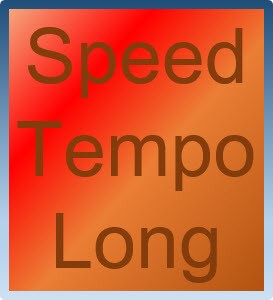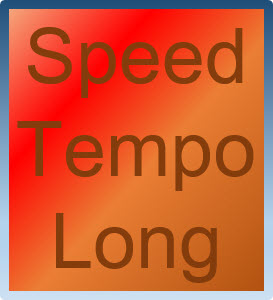The 3 Universal Elements of any Marathon Training Plan
 If you’ve ever trained for a marathon you may have noticed that they all have certain things in common. There is a core set of 3 elements that are in every good plan. When you start to understand these 3 elements and why they are important you can judge the applicability of that plan to your personal goals.
If you’ve ever trained for a marathon you may have noticed that they all have certain things in common. There is a core set of 3 elements that are in every good plan. When you start to understand these 3 elements and why they are important you can judge the applicability of that plan to your personal goals.
What are the 3 universal elements of any training plan?
Speed
Tempo
Long
That’s it. At the core of every marathon plan are these elements. Depending on your personal goal the mix will be different, but they are the core of every training plan. They are at the base of all training plans from amateurs to professionals since the beginning of the modern marathon training epic.
If you look at an elite runner’s plan it will have these elements. If you look at how a Boston qualifier trains the plan will have these elements. It’s universal. If you understand this you can build your own plan or better assess what plans are right for you.
Beginner and novice plans may shift the balance all the way to zero speed and zero tempo, only focusing on gradually building up volume and distance with one weekly long run. The goal of these plans is just to finish so the plans have no speed or tempo.
The beginner and novice plans are probably structured this way so people who are new to the sport don’t get scared off or maybe to save them from too much intensity. But I would argue that even for beginners a plan totally devoid of any hard efforts is denying them the benefits and knowledge of that hard effort.
The beginner goal seems to be ‘do as little work as possible to finish the race’. Seems to me that this sells people short and denies them some key insights.
Once you get up to the intermediate plans you’ll see the speed and tempo start to pop into the plans.
Typically the first manifestation of this is to load one ‘hard’ session a week into the plan. If you look at it you’re going to see that it is essentially the beginner plan with more weekly volume and one hard day per week.
This is better than no hard workouts. But, because there is only one hard day a week these intermediate plans tend to mix in a mind-numbing variety of speed, tempo and specialty runs into that one day. One week you might be doing 400’s. The next maybe a fartlek and the next some hills.
It’s a collection of a little bit of every type of speed and tempo, almost like a ‘best of’ or ‘survey’ of hard workouts with a once a week appearance. It’s a bit random and lacks any consistency. You’ll benefit from the weekly hard workout variety but if your goal is time based, you could use your time more efficiently.
I would argue that this intermediate plan would actually be a great beginner plan. Give the new runners an introduction to the variety of workouts once a week. Let them feel some discomfort, know their body and learn something. It is certainly more interesting and engaging than the common beginner plan of ‘run this week and run more next week’.
Where you see the 3 core elements of a marathon training plan emerge are when you get into the advanced plans. Universally these plans will have 3 quality, purposeful workouts per week. These will take the form of 1.speed, 2.tempo and 3.long.
There are different cadences, but an example would be speed on Tuesday, tempo on Thursday, and long on Sunday.
What is speed?
Speed work is done at a level of effort that is at or beyond your threshold. For a marathon this might be 1-2 minutes per mile faster than your goal pace. Depending on your experience this might be close to your 5k race pace. To keep it simple, on a scale of 0-5, with 0 being stopped and 5 being max effort, speed is at an effort level of 4+.
Why do you want to run beyond your threshold?
Speedwork is super useful and critical if you want to run faster. It’s like lifting weights. When you increase the weights your muscles compensate by getting stronger. Speedwork is the running equivalent of lifting heavier weights. Speedwork is strength training.
Your body adapts to speedwork by getting physically stronger in the legs, and by building more capacity in your cardiovascular system. Your heart gets stronger, your lungs get stronger and your body gets better at moving blood and oxygen to the muscles.
Mentally speedwork gives you the confidence that you can run hard and recover. You learn to deal with discomfort, how to sublimate that discomfort and focus on the task at hand – racing.
Why not just do all speedwork if it’s so good for you?
Speedwork is not sustainable. By definition you are running beyond your threshold. That’s why the distances are typically shorter; 400’s, 800’s and 1600’s. You will not ever actually race at this pace in your marathon. If all you did was speedwork you’d be very fast…but only for a short distance, then you would crash once you burned up all your available resources.
In order to run a long race at a fast pace you need speedwork, but in order to cover the distance you need tempo and long.
What is tempo?
A tempo pace is a pace right at or just below your threshold, not over it. On a scale of 0-5, tempo effort would be 3-4. For a marathon this would be anywhere from race pace to a minute faster than race pace.
Tempo runs are longer than speedwork. Tempo runs as part of your training plan can get up to a half marathon in distance. The elites take these tempo runs up to 20 miles. For amateurs a typical tempo outing might be 4-8 miles.
Why do you need tempo?
Tempo simulates the kind of effort your body will need in a long race. Long periods of sustained effort. Not too fast, not too slow, just right, sustained effort. Over the course of a training plan consistent tempo work will actually move your threshold. You will be able to run longer at faster pace. This is how your body adapts to tempo.
Tempo is a great physical and mental trainer of pace. Have you ever had the experience of going out too fast and crashing at the end of a race? We all have. Tempo training will help you lock in to a sustainable race pace early. Tempo will give you pace discipline, awareness and efficiency.
Speed makes you faster. Tempo makes it sustainable.
What is long?
There’s no mystery to long runs as part of any training plan. Even the beginner plans have a long run. Traditionally the long run peaks around 20 miles in a marathon plan because someone, at some point in time, arbitrarily though that was a good number. Some plans go more, some go less.
Most plans have the long run at 30 seconds to a minute slower than your target race pace.
Why do you need a long run?
The point of the long run is not pace but time and distance. The long run gets you used to time and distance.
The long run trains your body to keep moving forward for longer than it wants to. Your body adapts by learning how to burn secondary fuel sources, like fat, and keep racing.
Mentally the long run gives you the confidence that you can go the distance.
What’s missing?
Like the donut hole the big piece that is missing from a plan with these 3 elements is the rest and recovery. You can’t go hard every day. That’s why even the advanced plans only have 3 quality workouts a week.
Your body doesn’t get faster during the speedwork. Your body gets faster during the recovery after the speedwork when it adapts to the effort. Same with tempo and long. Without the rest and recovery your body breaks down instead of improving.
The other piece that is missing is the cross training, stretching and other base maintenance that your body requires in order to be able to perform these quality workouts consistently.
Speed, Tempo and Long.
Every good marathon (and ½ marathon) plan will have the elements of speed, tempo and long. Practitioners have learned over the last 50 years that these elements of the plan complement each other and produce the strongest race results.
Like any other practice it is in the consistent performance of these workouts week after week that drives the improvement in your strength, speed, efficiency and endurance. You can’t just throw a hard workout in every so often and expect improvement or adaptation. You have to be consistent.
When you are looking for, or building your training plan don’t get confused by all the different workouts and options. They all fall under the same 3 elements.
Hills? That a flavor of speedwork. Fast-finish runs? That’s tempo. Fartleks? Tempo again. 400’s on the track? That’s speedwork.
Once you understand the purpose of the workout you can adapt the plan to suit your own personal goals.


Hey Chris,
Great podcast segment on the 3 elements of all marathon training programs. You did a great job providing a high-level summary that puts all the detailed “noise” into perspective.
Keep up the great podcasts, we’re counting on you! Also, I hope Hood to Coast is a great experience for you.
Take care,
Eric
Stoughton, WI
Thanks Eric.